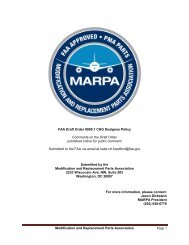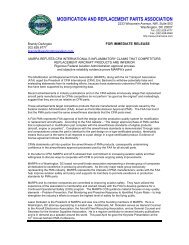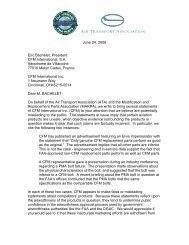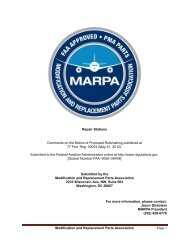Draft Order 8110.42 D - MARPA
Draft Order 8110.42 D - MARPA
Draft Order 8110.42 D - MARPA
Create successful ePaper yourself
Turn your PDF publications into a flip-book with our unique Google optimized e-Paper software.
FAA <strong>Order</strong> <strong>8110.42</strong>C elaborates on this requirement. Under the heading “Installation Eligibility” the<br />
<strong>Order</strong> explains that the ACO should “[e]xpect the applicant to identify where the part goes.” 2 The<br />
applicant may also be required to “[i]dentify at least one product for possible installation of the part.” 3<br />
Furthermore, proposed FAA Advisory Circular 21.303-PMA would also require the applicant to make a<br />
determination of installation eligibility. 4 The proposed AC directs the applicant to “[i]dentify the eligible<br />
aircraft, engines or propellers for proposed installation of [the applicant’s] article.” 5<br />
According to the regulations and guidance, the burden of identifying installation eligibility of a PMA<br />
article lies with the applicant. The role of the ACO is to review and verify the installation eligibility<br />
identified by the applicant. 6 However, the use of the word “propose” in describing the action required by<br />
the applicant may inadvertently cause some FAA personnel to regard the identified installation eligibility<br />
as subject to discussion. Although it is true the ACO personnel must verify installation eligibility, the<br />
prerogative to identify the products on which the PMA article will be installed lies with the applicant. If<br />
the FAA finds that the design and application comply with the relevant requirements, the FAA issues a<br />
PMA. 7<br />
Recommendation<br />
In order to avoid confusion by those referring to the Summary of FAA and Applicant Roles in PMA, the<br />
language used in Revision C, “Set installation eligibility,” should be retained. In the alternative, the<br />
language should be changed to read “Identify installation eligibility” to mirror 14 C.F.R. § 21.303(a)(1).<br />
Paragraph 2-1(d) Directs the Inspector to Evaluate Risk in Accordance with the<br />
RBRT Tool.<br />
Issue<br />
The draft <strong>Order</strong> includes a new subsection requiring the use of the Risk Based Resource Targeting<br />
(RBRT) tool. The use of the RBRT tool inserts a subjective assessment into the determination of PMA<br />
risk that will result in inconsistent application of FAA regulations and resources.<br />
Discussion<br />
The draft <strong>Order</strong> directs the ACO to perform a risk assessment of each PMA project using the RBRT tool<br />
to obtain a composite risk value. The RBRT tool directs the employee to consider factors such as the<br />
applicant’s relationship with the FAA, safety culture, organization stability, quality system, and use of<br />
suppliers and outside service providers. 8 These factors are to be assigned numerical values in order to<br />
reach a composite risk value. However, the RBRT tool does not contain guidance or metrics for<br />
assigning values to specific factors.<br />
2 FAA <strong>Order</strong> <strong>8110.42</strong>C at 10.<br />
3 Id.<br />
4 The proposed Advisory Circular removes guidance for PMA applicants from FAA <strong>Order</strong> <strong>8110.42</strong> revision D and<br />
would create a separate AC to instruct applicants.<br />
5 FAA <strong>Draft</strong> Advisory Circular 21.303-PMA at 5 (issued June XXXXXXXX).<br />
6 See FAA <strong>Draft</strong> <strong>Order</strong> <strong>8110.42</strong>D at 2-4.<br />
7 14 C.F.R. § 21.311.<br />
8 FAA <strong>Draft</strong> <strong>Order</strong> <strong>8110.42</strong>D at 2-1.<br />
Modification and Replacement Parts Association Page 6








